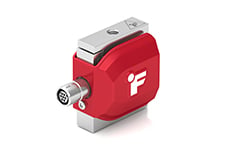Measuring fluid flow rate in food production, blood infusions, catheterization, and chemical compounding requires sanitary and sterile processes. Non-contact measurement solutions such as using an occlusion or obstruction of the tubing provide one type of flow measurement solution. Additionally, this technique allows for bubble and blockage detection.
How does an Occlusion Sensor work?
This non-invasive occlusion utilizes load cell technology to detect tubing occlusions. An artificial obstruction is created in the desired section of the tube using a clamping fixture. By restricting the tubing diameter and consequently the liquid flow, the fluid exerts an increased force onto the tubing. To measure the force exerted by the fluid on the occlusion, a load cell is incorporated into the clamping mechanism. The obstruction mechanism assembled with the load cell sensor can operate indirectly as a non contact flow sensor. The load cell will provide a proportional output that is then conditioned by the signal amplifiers.
The PLC and DAQ modules can trigger an alarm to alert the operator when the tube expansion is detected. The same principles of operation can apply in infusion pumps and devices designed for operation by medical professionals in settings such as hospitals, hospices, and home-care.
The sensors have no contact to the fluid and are suitable for all applications with strict hygienic requirements, e.g. biotechnology, pharmaceutical industries or chemical industry. In the medical equipment industry, occlusion sensors are often found in equipment such as:
- infusion pumps
- dialysis machines
- enteral feeding pumps
- other liquid processing equipment
Semiconductor Industry
Occlusion sensors are designed to detect the flow rate of liquids in rigid tubes of different diameters within a few milliseconds. This is a very common application in the semiconductor industry:
- wafer cleaning equipment;
- lithography equipment;
- mixing equipment;
- chemical supply systems; or
- slurry lines.
How it Works
An artificial restriction (occlusion) is placed at the desired point using a clamp.
One end of the clamp has FUTEK's LSB205 mounted between the clamp and the mount point.
By creating an artificial flow restriction (an occlusion), the fluid exerts an increased force onto the tubing.
The LSB205 measures the force applied to the occlusion by the fluid which can be correlated to fluid flow rate.
The LSB205 was chosen to provide a high accuracy and linearity force measurement with significant overload protection.
FUTEK's IAA Signal Conditioners Series and IDA100 amplify and transmit the load cell signal to the system PLC for flow measurement (fluid measurement using load cell).
Additionally, the IDA100 enables logging and monitoring of the load cell output via a PC with FUTEK's SENSIT software.
Products in Use
One FUTEK LSB200 Jr. Miniature S-Beam Load Cell paired with Instrumentation (IAA, IDA100)
The NanoSensors QLA414 or QLA424 can also be used as alternative cost-effective high-volume OEM solution with SPI interface.
Contact Us
Please Contact Us with questions.
Measuring fluid flow rate in food production, blood infusions, catheterization, and chemical compounding requires sanitary and sterile processes. Non-contact measurement solutions such as using an occlusion or obstruction of the tubing provide one type of flow measurement solution. Additionally, this technique allows for bubble and blockage detection.
How does an Occlusion Sensor work?
This non-invasive occlusion utilizes load cell technology to detect tubing occlusions. An artificial obstruction is created in the desired section of the tube using a clamping fixture. By restricting the tubing diameter and consequently the liquid flow, the fluid exerts an increased force onto the tubing. To measure the force exerted by the fluid on the occlusion, a load cell is incorporated into the clamping mechanism. The obstruction mechanism assembled with the load cell sensor can operate indirectly as a non contact flow sensor. The load cell will provide a proportional output that is then conditioned by the signal amplifiers.
The PLC and DAQ modules can trigger an alarm to alert the operator when the tube expansion is detected. The same principles of operation can apply in infusion pumps and devices designed for operation by medical professionals in settings such as hospitals, hospices, and home-care.
The sensors have no contact to the fluid and are suitable for all applications with strict hygienic requirements, e.g. biotechnology, pharmaceutical industries or chemical industry. In the medical equipment industry, occlusion sensors are often found in equipment such as:
- infusion pumps
- dialysis machines
- enteral feeding pumps
- other liquid processing equipment
Semiconductor Industry
Occlusion sensors are designed to detect the flow rate of liquids in rigid tubes of different diameters within a few milliseconds. This is a very common application in the semiconductor industry:
- wafer cleaning equipment;
- lithography equipment;
- mixing equipment;
- chemical supply systems; or
- slurry lines.






